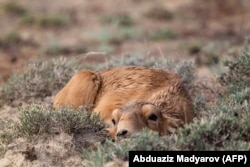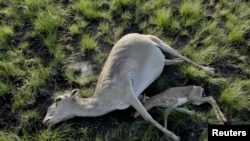ASTANA, Kazakhstan -- Kazakhstan is planning to cull up to 337,000 saiga antelope after the number of the once-endangered animal roaming the Kazakh steppe increased by tenfold in the past decade after a successful government conservation effort.
Astana will also end a moratorium on saiga hunting on December 31 in a bid to regulate the animal's population, which has has now reached some 2.6 million, according to the Ecology and Natural Resources Ministry.
Kazakh farmers have complained in recent years that large herds of saiga graze on their crops and destroy their livelihoods. The ministry says the antelope caused some $25.5 million in agricultural damage last year.
But experts warn that Kazakhstan should first establish measures to prevent poaching and other problems that drove the saiga to the verge of extinction in the 1990s.
Poachers kill male saiga for their horns, which are in high demand in neighboring China as an ingredient for traditional medicine. Saiga poaching skyrocketed in the Central Asian country after the fall of the Soviet Union.
Mass disease along with a lack of water and habitat led to the further decimation of Kazakhstan’s saiga.
Astana introduced a ban on saiga hunting in 1999 and set up strict anti-poaching measures to save the endangered animals.
A government count in May 2023 showed the saiga population in Kazakhstan has exceeded 1.9 million, marking a massive 45 percent increase from the previous year.
In 2003, the number of saiga in Kazakhstan stood at just over 20,000 -- but reached 257,000 in 2014.
The figures rose steadily despite a mysterious disease in 2015 that killed some 200,000 saiga in Kazakhstan, home to about 90 percent of the world’s saiga antelope.
'Another Mass Disease Can Strike At Any Moment'
Andrei Kim, deputy head of the Forestry and Fauna Committee at the Ecology and Natural Resources Ministry, told reporters on October 16 that authorities plan to cull between 10 to 20 percent of the saiga population.
The ministry says it will use two methods in the campaign -- capturing the animals using nets during the daytime or shooting them at night.
The culled saigas will be sold to meat-processing factories at a nominal price of about $0.64 per animal, according to Ecology and Natural Resources Minister Erlan Nysanbaev.
Nysanbaev insisted the campaign doesn’t aim at profiting from the meat sales and that the money will only “cover the ministry’s expenses.”
There was no mention of the selling of the male saiga’s horns, which can fetch up to $150 per horn. Saiga horns have been used as a substitute for the costly horns of rhinoceros. Trade in rhino horns was banned in 1993 as the animal became endangered.
The skin of the saiga is also of value and can be used to produce suede and other leather products.
The culling campaign is expected to be completed by the end of November.
But Sergei Sklyarenko, the science director at the Association for the Conservation of Biodiversity of Kazakhstan, says the government should not rush in the killing of such a large number of saiga.
“Such work cannot be started hastily. Everything must first be prepared and the work carried out gradually,” Sklyarenko said. “I would not start with culling 200,000 animals but with 20,000 to work out control mechanisms.”
Saiga are known to face mass die-offs from time to time with infectious diseases rapidly sweeping through the herds.
In 2015, a bacterial infection wiped out more than one-third of Kazakhstan’s saiga population in just a few weeks. Sklyarenko warned that “another mass illness could strike at any moment.”
With an artificially decreased number of saiga, “the situation will be impossible to control” if another disease breaks out, he said.
“The saiga will again vanish almost entirely,” he added.
Sklyarenko said Kazakhstan must introduce strict measures to prevent poaching, a major threat to the animal once the moratorium on hunting expires at the end of the year.
If concrete steps are not taken, the “saiga will be finished off again pretty quickly,” he warned.
The illegal hunting of saiga has continued over the past decade despite tough anti-poaching laws that stipulate up to 10 years in prison if violated. Hundreds of poachers have been caught and thousands of saiga horns confiscated by police.
Protecting the saiga from poaching can also be quite dangerous.
Two Kazakh wildlife rangers were killed and two others wounded by saiga poachers in two separate attacks in the Aqmola and Qaraghandy regions in 2019.












